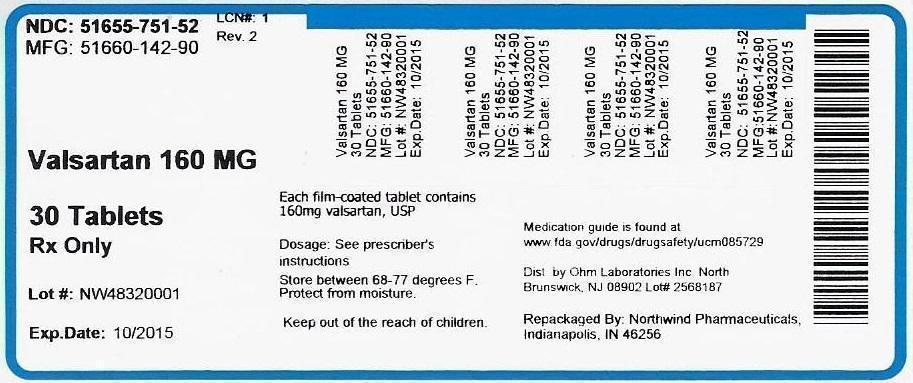Valsartan Recall
Get an alert when a recall is issued.
Questions & Answers
Side Effects & Adverse Reactions
There is currently no warning information available for this product. We apologize for any inconvenience.
Legal Issues
There is currently no legal information available for this drug.
FDA Safety Alerts
There are currently no FDA safety alerts available for this drug.
Manufacturer Warnings
There is currently no manufacturer warning information available for this drug.
FDA Labeling Changes
There are currently no FDA labeling changes available for this drug.
Uses
1.1 Hypertension
Valsartan tablets, USP are indicated for the treatment of hypertension, to lower blood pressure. Lowering blood pressure reduces the risk of fatal and nonfatal cardiovascular events, primarily strokes and myocardial infarctions. These benefits have been seen in controlled trials of antihypertensive drugs from a wide variety of pharmacologic classes including the class to which valsartan principally belongs. There are no controlled trials in hypertensive patients demonstrating risk reduction with valsartan tablets, USP.
Control of high blood pressure should be part of comprehensive cardiovascular risk management, including, as appropriate, lipid control, diabetes management, antithrombotic therapy, smoking cessation, exercise, and limited sodium intake. Many patients will require more than one drug to achieve blood pressure goals. For specific advice on goals and management, see published guidelines, such as those of the National High Blood Pressure Education Program’s Joint National Committee on Prevention, Detection, Evaluation, and Treatment of High Blood Pressure (JNC).
Numerous antihypertensive drugs, from a variety of pharmacologic classes and with different mechanisms of action, have been shown in randomized controlled trials to reduce cardiovascular morbidity and mortality, and it can be concluded that it is blood pressure reduction, and not some other pharmacologic property of the drugs, that is largely responsible for those benefits. The largest and most consistent cardiovascular outcome benefit has been a reduction in the risk of stroke, but reductions in myocardial infarction and cardiovascular mortality also have been seen regularly.
Elevated systolic or diastolic pressure causes increased cardiovascular risk, and the absolute risk increase per mmHg is greater at higher blood pressures, so that even modest reductions of severe hypertension can provide substantial benefit. Relative risk reduction from blood pressure reduction is similar across populations with varying absolute risk, so the absolute benefit is greater in patients who are at higher risk independent of their hypertension (for example, patients with diabetes or hyperlipidemia), and such patients would be expected to benefit from more aggressive treatment to a lower blood pressure goal.
Some antihypertensive drugs have smaller blood pressure effects (as monotherapy) in black patients, and many antihypertensive drugs have additional approved indications and effects (e.g., on angina, heart failure, or diabetic kidney disease). These considerations may guide selection of therapy.
Valsartan tablets, USP may be used alone or in combination with other antihypertensive agents.
1.2 Heart Failure
Valsartan tablets, USP are indicated for the treatment of heart failure (NYHA class II-IV). In a controlled clinical trial, valsartan tablets, USP significantly reduced hospitalizations for heart failure. There is no evidence that valsartan tablets, USP provide added benefits when it is used with an adequate dose of an ACE inhibitor. [See Clinical Studies (14.2)]
History
There is currently no drug history available for this drug.
Other Information
11 DESCRIPTION
Valsartan is a nonpeptide, orally active, and specific angiotensin II receptor blocker acting on the AT 1 receptor subtype.
Valsartan is chemically described as N-(1-oxopentyl)-N-[[2′-(1H-tetrazol-5-yl) [1,1′-biphenyl]-4-yl]methyl]-L-valine. Its molecular formula is C24H29N5O3, its molecular weight is 435.5, and its structural formula isvalstructure
Valsartan, USP is a white or almost white, hygroscopic powder. It is practically insoluble in water, soluble in methanol, freely soluble in anhydrous ethanol and sparingly soluble in methylene chloride.
Valsartan tablets, USP are available for oral administration, containing 40 mg, 80 mg, 160 mg or 320 mg of valsartan, USP. The inactive ingredients of the tablets are colloidal silicon dioxide, crospovidone, hypromellose, ferric oxide black (in 160 mg and 320 mg strength), ferric oxide red (in 80 mg, 160 mg, and 320 mg strength), ferric oxide yellow (in 40 mg, 80 mg, and 320 mg strength), magnesium stearate, microcrystalline cellulose, pregelatinized starch, polyethylene glycol, talc, and titanium dioxide.
USP dissolution test pending.
Sources





![Valsartan Tablet, Film Coated [Physicians Total Care, Inc.]](http://dailymed.nlm.nih.gov/dailymed/image.cfm?setid=ac24b6eb-346e-4acd-8de0-84373eb675f3&name=6452.jpg)
![Valsartan Tablet [Cardinal Health]](http://dailymed.nlm.nih.gov/dailymed/image.cfm?setid=d4746927-e6d4-463d-a084-56ffc48d1e67&name=BANI66PsorinumComplex7-13-15.jpg)
![Valsartan Tablet, Film Coated [American Health Packaging]](http://dailymed.nlm.nih.gov/dailymed/image.cfm?setid=27e6e580-4127-41db-ba01-9cfba0e61d6c&name=ValsartanTabletUSP160mglabel.jpg)
![Valsartan (Valsartan) Tablet, Film Coated [Avkare, Inc.]](http://www.recallguide.org/wp-content/themes/recallguide/assets/img/drug-image-placeholder.jpg)
![Valsartan Tablet, Film Coated [Teva Pharmaceuticals Usa Inc]](http://dailymed.nlm.nih.gov/dailymed/image.cfm?setid=e41319bc-517f-4b69-aa68-90d94ebfed4a&name=image-02.jpg)
![Valsartan Tablet [Alembic Pharmaceuticals Limited]](http://dailymed.nlm.nih.gov/dailymed/image.cfm?setid=6e2cd953-88bf-4094-8ba8-2c9ba020f4d7&name=valsartan-160mg.jpg)
![Valsartan Tablet [Torrent Pharmaceuticals Limited]](http://dailymed.nlm.nih.gov/dailymed/image.cfm?setid=6365803f-61f8-476d-b760-c70daa17d551&name=0432499f-0ae5-4f12-898e-1f5325f6b487-04.jpg)
![Valsartan Tablet, Film Coated [Camber Pharmaceuticals, Inc.]](http://dailymed.nlm.nih.gov/dailymed/image.cfm?setid=0ff36e83-b307-42db-a2ab-bae3f6805c20&name=160mg30s.jpg)
![Valsartan Tablet, Film Coated [Aurobindo Pharma Limited]](http://dailymed.nlm.nih.gov/dailymed/image.cfm?setid=f5a66541-1b15-4dfe-91e0-d8d5f8fdc7fb&name=image-01.jpg)
![Valsartan Tablet, Film Coated [Northwind Pharmaceuticals, Llc]](http://dailymed.nlm.nih.gov/dailymed/image.cfm?setid=4e2fae79-b8e0-4467-a684-871ba46852be&name=51655-652-52.jpg)
![Valsartan Tablet, Film Coated [Northwind Pharmaceuticals, Llc]](http://dailymed.nlm.nih.gov/dailymed/image.cfm?setid=f56c5ab3-cf69-499b-abe2-41663457880e&name=51655-651-52.jpg)
![Valsartan Tablet [Sandoz Inc]](http://dailymed.nlm.nih.gov/dailymed/image.cfm?setid=62ee362f-3032-4f56-a900-4d2485b8759c&name=valsartan-3.jpg)
![Valsartan Tablet, Film Coated [Ohm Laboratories Inc.]](http://dailymed.nlm.nih.gov/dailymed/image.cfm?setid=ab5e0e5a-5bdf-4cfc-9d18-57ea4d642f65&name=ohmvala160.jpg)
![Valsartan Tablet [American Health Packaging]](http://dailymed.nlm.nih.gov/dailymed/image.cfm?setid=1dd3d934-efee-4fdb-ae6f-f47b61831a2e&name=CarbamazepineTabletsUSP200mgLabel.jpg)